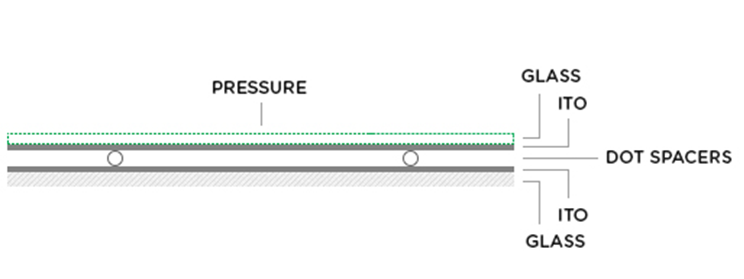¿Cuáles son los diferentes tipos de pantalla táctil?
Una pantalla táctil tiene la capacidad de detectar un toque dentro del área de visualización determinada. Se compone de 3 elementos básicos, un sensor, un controlador y un controlador de software.
Todas las variantes de la tecnología de pantalla táctil tienen sus propias características distintivas, con beneficios y limitaciones individuales.

Pantalla táctil resistiva se puede dividir en modelos de 4, 5,6, 7 u 8 cables, que diferencian entre las coordenadas de tacto. Como una de las pantallas táctiles resistivas más utilizadas, se basa en una superposición táctil, construida por una capa superior flexible y una capa inferior rígida, divididas por puntos espaciadores aislantes. La superficie interior está recubierta con un material transparente (ITO) que establece contacto eléctrico cuando se aplica presión. Estos voltajes luego se convierten en coordenadas X e Y, que se envían al controlador. Si bien las pantallas resistivas son duraderas y fáciles de integrar, solo pueden ofrecer un 75 % de claridad.

Comúnmente utilizadas con fines industriales, las pantallas táctiles capacitivas consisten en una capa de vidrio recubierta con un material conductor como el óxido de indio y estaño. El contacto con una pantalla capacitiva crea una carga electrostática que envía información al control táctil para que pueda realizar su función. Este tipo de pantalla táctil tiene muy buena claridad y durabilidad, excepto que solo pueden responder al toque de un dedo o guantes especiales a menos que tenga carga capacitiva.

La tecnología de pantalla táctil SAW se basa en dos transductores y un reflector colocados en la superficie del vidrio. Las ondas se dispersan a través de la pantalla rebotando en la disposición del reflector y son recibidas por los transductores. El tacto se detecta cuando las ondas son absorbidas. En comparación con las otras pantallas táctiles; SAW proporciona claridad, resolución y durabilidad superiores, con la capacidad de interactuar con un lápiz o guantes.

A diferencia de los otros tipos, la tecnología de pantalla táctil infrarroja no incorpora una superposición. En cambio, un marco que rodea la pantalla consta de LED en un lado y detectores de fototransistores en el otro. Los fototransistores detectan la ausencia de luz y transmiten una señal que determina las coordenadas. El toque se identifica y sitúa en el punto de interrupción de los haces LED. Las pantallas táctiles infrarrojas, comúnmente utilizadas en lugares al aire libre, son duraderas y pueden detectar cualquier entrada.

Utilizando sensores ópticos para reconocer el tacto, esta tecnología de pantalla táctil es popular por su versatilidad y escalabilidad. Las imágenes ópticas se basan en luces infrarrojas. En la parte superior se encuentran dos sensores de imágenes infrarrojas que también funcionan como emisores y cintas retrorreflectantes en los tres lados. Las luces emitidas se reflejan de regreso a los sensores de imágenes, que se bloquean en el punto de contacto y crean una sombra para localizar el toque.

Una pantalla táctil APR está formada por una capa de vidrio y cuatro transductores conectados al exterior posterior. Cuando se toca la pantalla, la fricción crea ondas acústicas. Los transductores detectan la onda acústica, que luego se convierte en una señal. Las pantallas táctiles APR son resistentes al agua, duraderas y escalables.